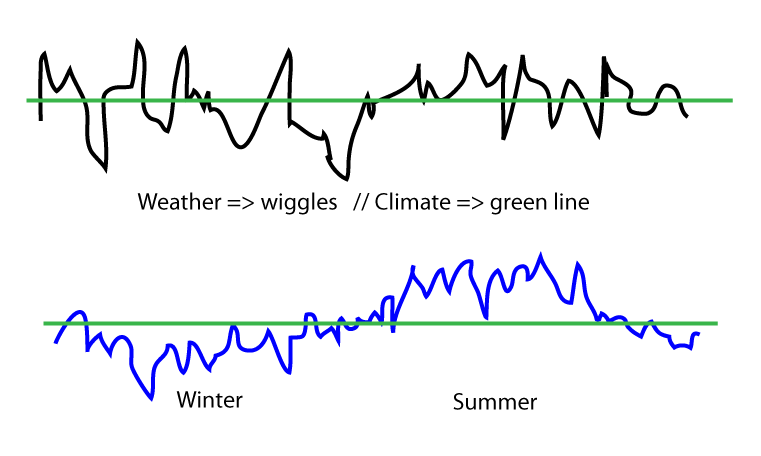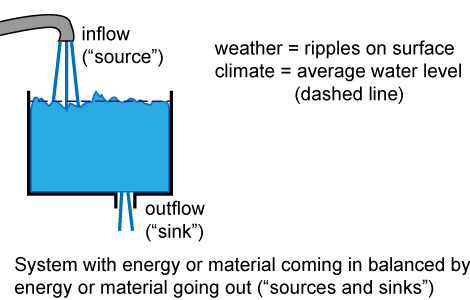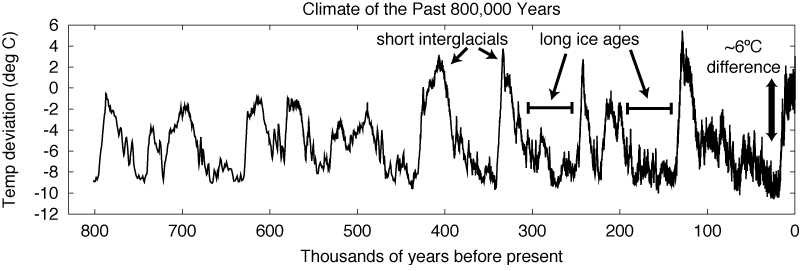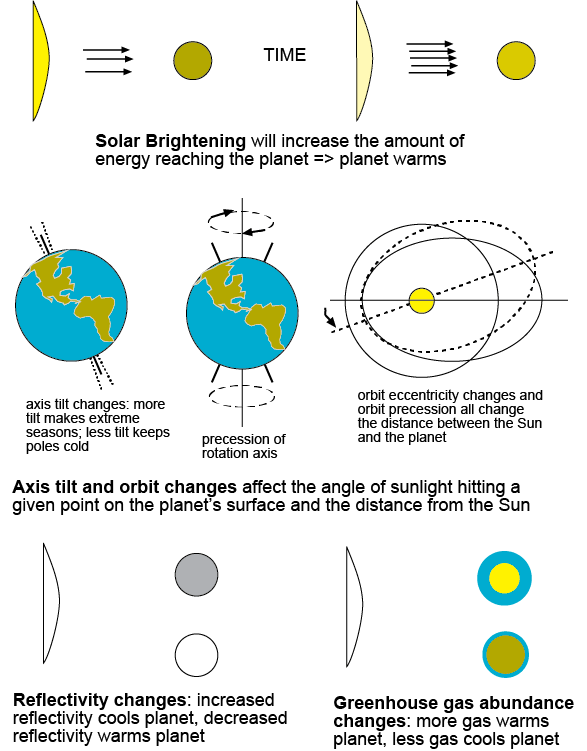
Video lecture for Atmospheres section
The preceding sections have talked about weather and climate and what affects them. Weather is often confused with climate, so this section will explain the difference between them as well as what can produce changes in a planet's global climate. The figure below illustrates the difference between weather and climate.

Weather is the ever-changing combination of winds, clouds, temperature, and pressure at a particular location and time. Climate is the long-term average of weather (usually 30 years or longer for Earth climate), which means it can change only on much longer time scales. The long-term averaging removes the chaotic wiggles making it possible to make long-term predictions of future climate. Weather predictions vs. climate predictions is analogous to not being able to predict if a particular coin toss will be heads or if it will be tails but you can easily predict the statistical results of a large number of coin tosses. Another analogy David Archer uses in his book The Long Thaw involves water in a sink with water flowing into it via a faucet and water flowing out via a drain: weather is like the ripples on the surface of the water while the average water level in the sink would be climate. Predicting the average water level in the sink is much easier than predicting all of the features of the ripples on the surface.

For more on climate vs. weather, see the FAQ 1.2 of the Climate Change 2007: Working Group I report of the IPCC. PBS LearningMedia also a great video about the difference between weather and climate. The hydrological (water) cycle, mountain ranges (rain shadows), and ocean currents all play key roles in determining climate on the Earth.

The Earth's geological, paleontological, cryological, and even historical records show that climates can change but, by definition, these changes take place over decades at least on up to millennia. Careful study of the polar ice caps on Mars and other surface features show that Mars has also undergone climate changes, some drastic. Venus was once a more comfortable place but it underwent a drastic global climate change as well to become a hellishly hot and very dry place.
One of the records we have for reconstructing the temperature of the Earth to times more than 800,000 years ago are ice cores drilled into the ice sheets in Antarctica and Greenland (a cryological record). Below are temperature reconstructions from deuterium isotope abundance measurements in ice cores drilled by the EPICA group at Dome C in Antarctica (data courtesy of Jouzel, J., et al).

The records show a cyclic pattern of brief warm spells called interglacials (the peaks in the graph) separated by long cold spells, the ice ages. The pattern repeats with a period of approximately 100,000 years. Because there were no thermometers way back then, temperature reconstructions must use measurements of isotope abundances such as deuterium (hydrogen-2) or oxygen-18 to create temperature data. The isotope measurement methods use the fact that water made of oxygen-18 and/or deuterium will evaporate and condense (then precipitate) differently than ordinary water (made of hydrogen-1 and oxygen-16) because of differences in the masses of the isotopes. Water made of the lighter isotopes evaporates more easily and water made from the heavier isotopes condenses and precipitates out more readily. When the climate near the poles is colder than usual, the separation of the isotopes from the water vapor in the air is more pronounced. The result is that ice sheets are isotopically light and the oceans are isotopically heavy.
Oxygen in the oceans can get incorporated in the calcium carbonate in marine shells. Measuring the amount of oxygen-18 in fossil marine shells of different ages can give us a record of the global climate throughout time because the oceans are well-mixed over very short timescales, geologically speaking. The deuterium in ice cores and oxygen-18 in fossil marine shells give very similar results. That tells us that the data and conclusions derived from them are reliable since the very different data come from totally different places.
Another thing the plot shows is that the temperature climbs very quickly and then falls back down more gradually. The pattern is the result of subtle changes in the Earth's orbit and tilt (described more fully below), along with complex feedback loops involving water, carbon dioxide, and other trace molecules in the climate system.
Going much further back in time, the geological records show that between 580 million and 750 million years ago, the Earth experienced some particularly severe ice ages with glaciers going all the way to the equator. A time of such extreme ice age is called Snowball Earth. Earth was able to get out of the Snowball Earth phases via climate change agents described below. Evidence for the Snowball Earth episodes comes from glacial sediments that were embedded within icebergs. The sediments of material from the middle of continents were deposited on the ocean floor far from where the glaciers would have met the oceans. Also glaciers grind up surface rock and the glaciers carry the debris along with them and deposit them in rubble piles called moraines. Rocks moving with the glaciers can scratch the surface rock layer to create long, parallel scratches. These glacier-formed features are found in places that would have been near the equator when they were created. Another piece of evidence for the Snowball Earth episodes is described in a later section about the carbon cycle.
Recalling what affects the surface temperature of a terrestrial planet, we can make a brief list of what can cause long-term climate changes: solar brightening, changes in the orbit and axis tilt, change in reflectivity, and changes in greenhouse gas abundance.
Observations of solar-type stars and our understanding of how the nuclear fusion rates in the core of the Sun change as it uses up its hydrogen in its core tell us that the Sun will gradually brighten with time. The Sun was about 30% dimmer when it formed 4.6 billion years ago than it is now. Because this process is so gradual, with effects taking tens of millions of years to be noticeable, other climate change effects described below are much more important in the short-term. These other effects have actually made Earth and Mars cooler now than they were in the past instead of hotter.

Increases in the albedo of a planet will mean less solar energy absorbed and therefore cooling of the planet. Natural ways to increase a planet's albedo are through volcanic eruptions---the dust particles reflect the sunlight (the smaller they are, the more they reflect), increased ice coverage, and increased cloud cover. On the Earth, if the volcanic dust can reach the stratosphere, it can spread around the globe and stay aloft for several years. A natural way to decrease a planet's albedo is through melting of ice. On the Earth, human activity has led to increases and decreases in the Earth's reflectivity of which we are still trying to determine the net effect. Smog acts like the volcanic dust particles to increase the albedo. Deforestation also increases the albedo by removing the sunlight absorbing plants. However, building of cities and roads tend to make the surface darker, the so-called "urban heat island" effect.
More greenhouse gases in the atmosphere usually mean more infrared energy is trapped close to the planet's surface. A warmer surface can lead to increased evaporation or sublimation (ice directly to vapor) and therefore increase the surface air pressure. On the Earth, the increased amount of water vapor would further amplify the greenhouse effect from carbon dioxide and methane. Decreased greenhouse gases usually mean cooler temperatures and if the cooling is great enough (as found on Mars, for example), a drop in atmospheric pressure as gases freeze. Note that I inserted the word "usually" in the expected trends as a warming planet from increased greenhouse gas abundance could have increased cloud cover which may dampen or delay the warming because of the increased albedo. Clouds and dust (aerosols) create the largest uncertainties in our current climate models. Aerosols are very small droplets of material or particles suspended in the atmosphere like dust and sulfuric acid droplets but are not water droplets or ice. However, they can serve as the nuclei around which water can accumulate to make clouds, so they can have a direct effect of reflecting sunlight or an indirect effect of creating clouds that reflect sunlight (see the aerosol formation and climate page on RealClimate for more details).
Because of water's short residency time in our atmosphere (a water molecule will be in the atmosphere for about a week) and the amount of water vapor present depends very sensitively on the temperature, water vapor is considered just an enhancer of climate change by the greenhouse effect rather than an agent of change. If another gas starts to warm a planet, the increased amount of water vapor from evaporation will approximately double the greenhouse effect of the other gas. Similarly, if a decrease in another gas cools the planet, the amount of water vapor will drop too to further weaken the greenhouse effect. In this way water vapor creates a positive feedback. A positive feedback enhances whatever initial change is made in a system. A negative feedback dampens any initial change in a system to return it back to its original state. An example in another area of experience: if you put a microphone next to a speaker, a positive feedback creates the high-pitched, very loud squeal. When you move the microphone away from the speaker to minimize the squeal, that's a negative feedback. A good illustration of positive and negative feedback loops is the "DaisyWorld" world model video (see also this link to the video).
Other gases like carbon dioxide have much longer residency times (decades to centuries). Their presence does not depend so sensitively on the temperature so they can be agents of change moving a climate system out of balance. In the climate change research, the long-lived gases are called radiative forcing agents while water vapor is just a feedback actor.
Gravitational interactions of a planet, its moons, and the other planets of the solar system cause the tilt of the planet's rotation axis to change and the planet's orbit to change shape and orientation in a periodic way. In addition, the rotation axis precesses. Put all of these agents together, all with different periods, and they can create dramatic changes in a planet's climate by changing the insolation: the angle of sunlight hitting a given point on the planet's surface and the amount of solar radiation reaching the planet's surface. Adding in the other agents of climate change above can make the effects from even subtle changes in the axis or orbit much more significant.
The angle of the tilt of the Earth's rotation axis varies about its current value of 23.44 degrees from between about 22 degrees and 25 degrees with a period of approximately 41,000 years. Larger tilt creates more extreme seasons---warmer summers and colder winters. A decreasing tilt is thought to bring about ice ages because the milder summers allow ice and snow to last throughout the year in the higher latitudes (closer to the poles). This increased ice coverage increases the reflectivity of a planet compounding the effect of the milder summers. It also appears that the amount of carbon dioxide falls as ice sheets grow, leading to further cooling. The amount of the tilt of the Earth's rotation axis is prevented from changing too much because of the stabilizing influence of the Moon's gravity. Mars' rotation axis is now about 25.2, close to the Earth's tilt, so it experiences seasons similar to ours (though roughly twice as long because of its larger orbit). Mars does not have any massive moons so it has experienced much wilder fluctuations in its rotation axis tilt throughout its history---between 13 and 40 degrees and maybe up to 60 degrees over a 100,000-year cycle (the second link brings up a book in Google books---go to p. 167). Mars is also closer to Jupiter so Jupiter's gravity has a greater influence in perturbing Mars' rotation axis than Jupiter has with the Earth. Recent evidence of these climate cycles on Mars can be seen in the Mars Reconnaissance Orbiter's observations of rock layering and of layering of the polar ice caps.
Recall from the seasons section in the third chapter that the Earth's orbit is elliptical and that it gets closest in early January. With an orbit eccentricity of 0.0167, Earth receives about 7% more solar energy in early January than at its aphelion point in early July. The Earth's orbit changes eccentricity on cycles of about 100,000 and about 400,000 years. At greatest eccentricity, the Earth can receive over 20% more solar energy at perihelion than at aphelion. Mars has a more elliptical orbit than the Earth and as a result, its southern hemisphere winters are long and extreme while its northern hemisphere winters are short and milder.
The coordinates section of the third chapter discusses the precession of the Earth's rotation axis that is caused by the Sun's gravity and the Moon's gravity pulling on the non-perfectly round Earth. The Earth bulges a bit at the equator and is flattened at the poles primarily because of its rapid spin. The Sun's and Moon's gravities cause the rotation axis to slowly wobble with a period of 26,000 years. Another precession is with the orbit of the Earth. The slight influences of the other planets in the solar system, primarily Jupiter and Saturn, cause the perihelion direction to shift. This reduces the cycle of when perihelion would occur from 26,000 years to about 21,600 years.
For the Earth we have an approximately 41,000-year axis tilt period plus the 100,000-year and 400,000-year cycles of variation in the Earth's orbit shape. Add in the 21,600-year cycle of precession of the Earth's perihelion date, you will find the net effect to be quite complex to predict. James Croll in the mid-1800s suspected that these orbit variations might cause the rise and fall of the ice ages. Later, in the early 1900s, Milutin Milankovitch quantified the changes and developed the mathematical theory behind the orbit/tilt variations and so these cycles are called Milankovitch cycles in his honor. Milankovitch's calculations have been refined since his time but the basic idea of his theory is still valid. Past ice ages correlate well to the summer insolation at 65 deg N latitude. The northern hemisphere is more important because of the greater amount of land area in the northern hemisphere compared to the southern hemisphere---the oceans have a larger heat capacity than land and so they tend to dampen changes in the temperature.
However, the axis tilt and orbit variations cannot by themselves, explain the magnitude and quickness of the temperature changes between the ice ages and the interglacials. One has to include the effects of reflectivity changes and greenhouse gas abundance changes---the positive and negative feedback effects of them---to explain the magnitude and quickness of the temperature changes fully. For more on the Milankovitch cycles, see the Astronomical Theory of Climate Change webpage on the NOAA Paleoclimatology website (and the links therein). PBS NOVA has a great video about the natural climate cycles in "Decoding the Weather Machine" archive.
![]() Go back to previous section --
Go back to previous section --
![]() Go to next section
Go to next section
last updated: April 4, 2024